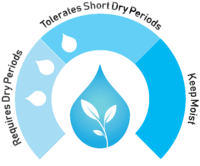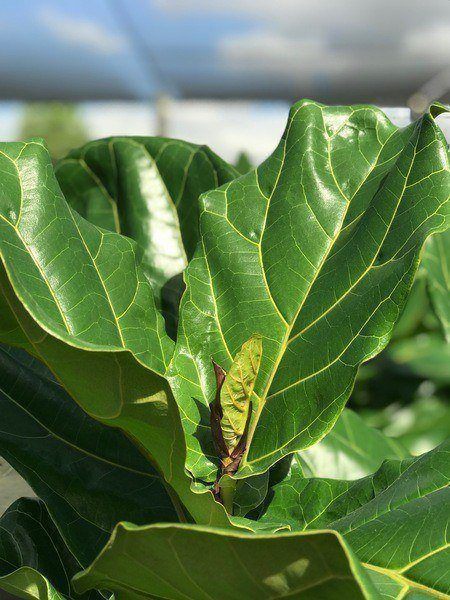
The lyrata goes by the common name fiddle leaf fig and is one of the most popular tropical foliage plants for indoor use on the market today. For a houseplant, the fiddle leaf fig requires a well lit environment, but uses very little water. See Ficus lyrata care information below. We grow the Ficus lyrata in a variety of shapes and sizes from small bushes to 14 feet standards with large caliper trunks.
The meters below indicate a range of light and tolerance to drought. The ranges are indicated by the little light bulbs and the small water drops.
Light Instructions

Water Instructions


From the Grower:
Mites should be primarily controlled with predator mites. Neoseiulus californicus,(Spical, Spical Plus, Californiline) and Phytoseiulus persimilis,(Spidex, Bio Persimilis, Phytoline) are two excellent choices for spider mite control. If a mite infestation is exceptionally bad, prior to the release of predator mites, spray the plant with water or horticultural oil. Both will provide some knockdown control of spider mites and will not leave a toxic residue that may effect predator mites. If the population of spider mites is red in color, (as opposed to pale yellow with 2 dark black spots) then californicus mites are the only option. Even these predators do not feed heavily on the red spider mite. In this case spraying is the best option. Use a miticide that works well with californicus predator mites (Sultan, Floramite SC, Shuttle O).
Mealybugs can be removed with a systemic insecticide drench and hand cleaning. If pesticides are not an option, try horticultural oil directly sprayed onto the insects. A second and third treatment, if using oils, will be necessary. Space out the sprays at 1 week intervals to break up the mealybug life cycle. Mealybugs like to hide against the stem, just below the newest one or two leaves, inside the dried remains of the leaf sheath (Link to pictures below).
Aphids can be controlled in the same way as mealybugs.
Thrips can cause red lines and spots on the newest emerging leaf. Check the link below for pictures of thrip damage. Thrips are difficult to find. They most likely will be inside the leaf sheath of the newest leaf. Let the lyrata dry to prevent the production of a new leaf and spray horticultural oil on the newest foliage. Repeat treatments of the oil spray on a weekly basis for 3 weeks then observe.
Lyrata can be kept very dry without negative consequences. With a surplus of water the lyrata will try to grow too rapidly given certain conditions. Since many pests like the newest soft foliage reducing the number of new soft leaves can be advantageous.
Large dry brown dead areas of a leaf indicate low light damage. Parts of a lyrata leaf may die while the rest of the leaf is still nice. This happens when a higher leaf is shading a lower leaf. The portion of the lower leaf being shaded may die. It is also common to see the foliage away from the light source look noticeable worse than those facing the light source. When this is happening to upper foliage, that is not being shaded, the entire area is too dark to sustain the Ficus lyrata. Move it to a brighter area. Overwatering to the point of root death may also cause leaf spots but these are usually accompanied by leaf drop and other drastic indications that something is wrong with the entire plant.
The Cuban Brown Snail can be a pest of Ficus lyrata. This snail is not supposed to be shipped with any plant, but it can happen. The Cuban Brown Snail is active at night and can do significant damage to a plant in one night. A large CBN can eat multiple whole leaves in one night. If you see this type of damage, usually accompanied by a squiggly pile of snail excrement, look in the top 1 inch of soil for the snail. If you find one crush it. Don't worry we have more and you don't want this snail where you live. Also, please call us and let us know as this is a situation we try hard to avoid.
Other Links
Mealybugs, Thrips and other problems of Ficus lyrata
personcory
starstarstarstarstarbeautiful!
April 18th, 2024really, you can't find better looking healthier Lyratas anywhere! Always so clean and consistent.
Ficus elastica 'Abidjan'
Ficus lyrata
Ficus maclellandii 'Alli'
